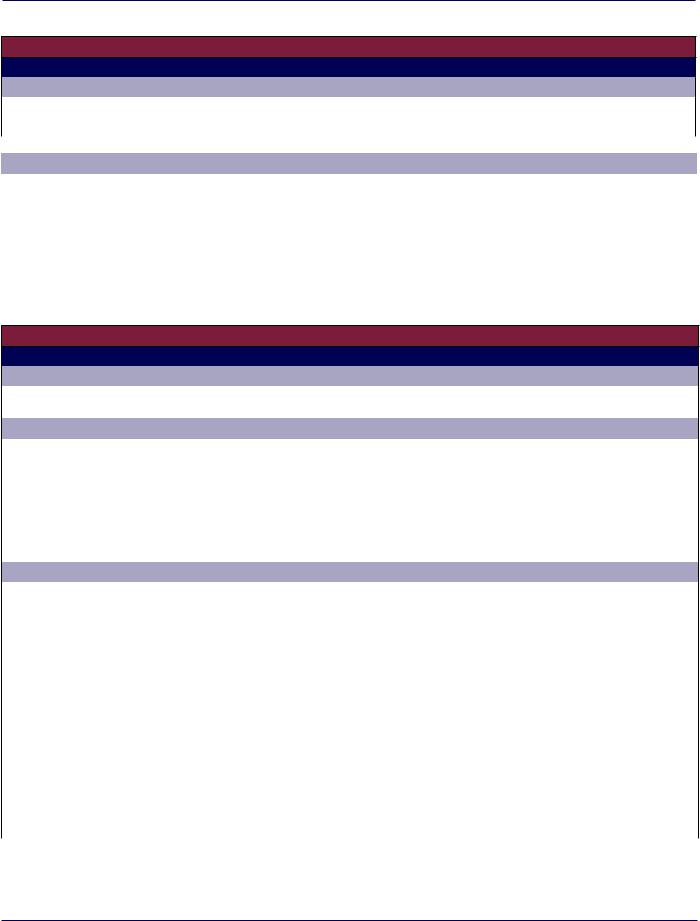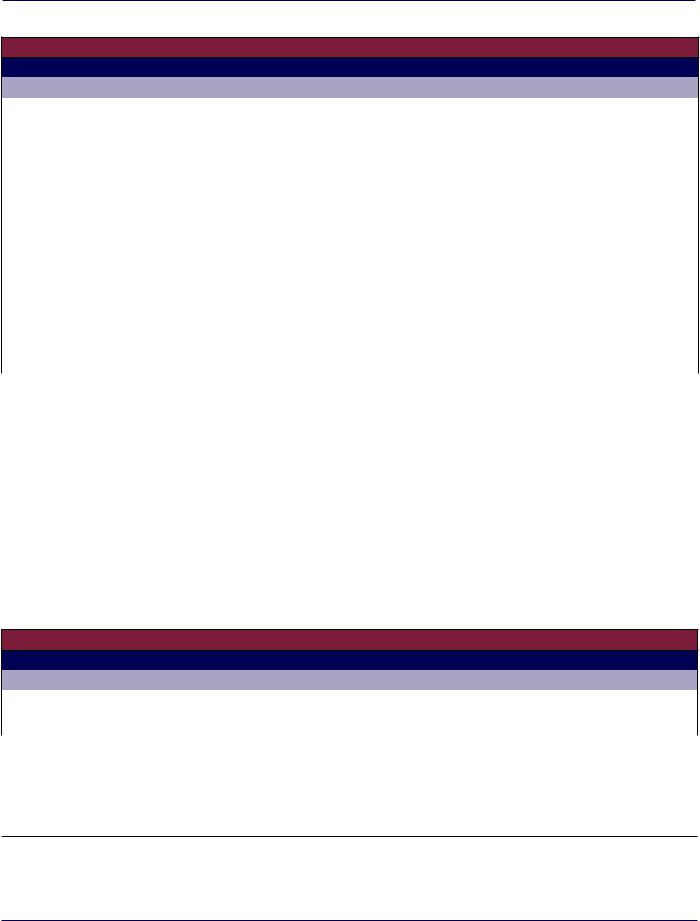
- •1.1 COBIT as an Information and Technology Governance Framework
- •1.1.1 What Is COBIT and What Is It Not?
- •1.2 Overview of COBIT® 2019
- •1.3 Terminology and Key Concepts of the COBIT Framework
- •1.3.1 Governance and Management Objectives
- •1.3.2 Components of the Governance System
- •1.3.3 Focus Areas
- •Chapter 2 Structure of This Publication and Intended Audience
- •2.1 Structure of This Publication
- •2.2 Intended Audience
- •Chapter 3 Structure of COBIT Governance and Management Objectives
- •3.1 Introduction
- •3.2 Governance and Management Objectives
- •3.3 Goals Cascade
- •3.4 Component: Process
- •3.5 Component: Organizational Structures
- •3.6 Component: Information Flows and Items
- •3.8 Component: Policies and Procedures
- •3.9 Component: Culture, Ethics and Behavior
- •3.10 Component: Services, Infrastructure and Applications
- •Chapter 4 COBIT Governance and Management Objectives—Detailed Guidance
- •COBIT Core Model
- •4.1 Evaluate, Direct and Monitor (EDM)
- •4.2 Align, Plan and Organize (APO)
- •4.3 Build, Acquire and Implement (BAI)
- •4.4 Deliver, Service and Support (DSS)
- •4.5 Monitor, Evaluate and Assess (MEA)
- •Appendices
- •5.1 Appendix A: Goals Cascade—Mapping Tables
- •5.1.1 Mapping Table: Enterprise Goals—Alignment Goals
- •5.1.2 Mapping Table: Alignment Goals—Governance and Management Objectives
- •5.2 Appendix B: Organizational Structures—Overview and Descriptions
- •5.3 Appendix C: Detailed List of References

COBIT® 2019 FRAMEWORK: GOVERNANCE AND MANAGEMENT OBJECTIVES
•Head Architect
•Head Development
•Head IT Operations
•Head IT Administration
•Service Manager
•Information Security Manager
•Business Continuity Manager
•Privacy Officer
•Legal Counsel
•Compliance
•Audit
A detailed description of each of these roles and organizational structures is included in Appendix B. The different levels of involvement included for these structures can be divided into responsible and accountable levels.
•Responsible (R) roles take the main operational stake in fulfilling the practice and create the intended outcome. Who is getting the task done? Who drives the task?
•Accountable (A) roles carry overall accountability. As a principle, accountability cannot be shared. Who accounts for the success and achievement of the task?
Each domain describes the organizational structures that have responsibility and/or accountability in the domain. A detailed description of each of role and organizational structure is included. Other organizational structures without responsibility or accountability have been omitted to improve readability of the chart.
Practitioners can complete charts by adding two levels of involvement for roles and organizational structures. Since the attribution of consulted and informed roles depends on organizational context and priorities, they are not included in this detailed guidance.
•Consulted (C) roles provide input for the practice. Who is providing input?
•Informed (I) roles are informed of the achievements and/or deliverables of the practice. Who is receiving information?
Enterprises should review levels of responsibility and accountability, consulted and informed, and update roles and organizational structures in the chart according to the enterprise’s context, priorities and preferred terminology.
Where relevant, references to other standards and additional guidance are included in the organizational structure components section. The Related Guidance refers to all standards, frameworks, compliance requirements and other guidance that are relevant for the organizational structures at hand and their levels of involvement in the process. The detailed reference area cites specific chapters or sections within related guidance. A complete list of sources is included in Appendix C.
3.6 Component: Information Flows and Items
The third governance component provides guidance on the information flows and items linked with process practices. Each practice includes inputs and outputs, with indications of origin and destination.
In general, each output is sent to one or a limited number of destinations, typically another COBIT process practice. That output then becomes an input to its destination (figure 3.7).
22

CHAPTER 3 STRUCTURE OF COBIT GOVERNANCE AND MANAGEMENT OBJECTIVES
Figure 3.7—Display of Information Flows and Items Component
C. Component: Information Flows and Items
Governance/Management Practice |
|
Inputs |
|
|
Outputs |
|||
|
|
|
|
|
|
|
|
|
<REF> <NAME> |
|
From |
|
|
Description |
Description |
|
To |
<REF> |
|
<TEXT> |
<TEXT> |
|
<REF> |
|||
|
|
|
||||||
|
|
|
|
|
|
|
|
|
|
|
|
|
|
|
|||
Related Guidance (Standards, Frameworks, Compliance Requirements) |
|
Detailed Reference |
|
|
|
|||
|
|
|
|
|
|
|
|
|
<STANDARD NAME> |
|
|
|
<TEXT> |
|
|
|
|
|
|
|
|
|
|
|
|
|
<STANDARD NAME> |
|
|
|
<TEXT> |
|
|
|
|
A number of outputs, however, have many destinations (e.g., all COBIT processes or all processes within a domain). For readability reasons, these outputs are not listed as inputs in the target processes. A complete list of such outputs is included in figure 3.8.
For some inputs/outputs, “internal” is cited as a destination if input and output are shared between activities within the same process.
Figure 3.8—Outputs to Multiple Processes
Outputs to All Processes
From Key Practice |
Output Description |
Destination |
|
|
|
APO13.02 |
Information security risk treatment plan |
All EDM, All APO; All BAI, All DSS; |
|
All MEA |
|
|
|
|
From Governance Practice |
Output Description |
Destination |
EDM01.01 |
Enterprise governance guiding principles |
All EDM |
|
|
|
EDM01.01 |
Decision-making model |
All EDM |
EDM01.02 |
Enterprise governance communication |
All EDM |
EDM01.01 |
Authority levels |
All EDM |
|
|
|
EDM01.03 |
Feedback on governance effectiveness and performance |
All EDM |
|
Outputs to All Management Processes |
|
From Management Practice |
Output Description |
Destination |
|
|
|
APO01.01 |
Management system design |
All APO; All BAI; All DSS; All MEA |
APO01.01 |
Priority governance and management objectives |
All APO; All BAI; All DSS; All MEA |
APO01.02 |
Communication on I&T objectives |
All APO; All BAI; All DSS; All MEA |
|
|
|
APO01.02 |
Communication ground rules |
All APO; All BAI; All DSS; All MEA |
APO01.03 |
Target model gap analysis |
All APO; All BAI; All DSS; All MEA |
APO01.11 |
Process improvement opportunities |
All APO; All BAI; All DSS; All MEA |
|
|
|
APO02.05 |
I&T strategy and objectives |
All APO; All BAI; All DSS; All MEA |
APO02.06 |
Communication package |
All APO; All BAI; All DSS; All MEA |
APO11.03 |
Quality management standards |
All APO; All BAI; All DSS; All MEA |
|
|
|
APO11.04 |
Process quality of service goals and metrics |
All APO; All BAI; All DSS; All MEA |
APO11.05 |
Communications on continual improvement and best practices |
All APO; All BAI; All DSS; All MEA |
APO11.05 |
Examples of good practice to be shared |
All APO; All BAI; All DSS; All MEA |
|
|
|
APO11.05 |
Quality review benchmark results |
All APO; All BAI; All DSS; All MEA |
23

COBIT® 2019 FRAMEWORK: GOVERNANCE AND MANAGEMENT OBJECTIVES
Figure 3.8—Outputs to Multiple Processes (cont.)
Outputs to All Management Processes
From Management Practice |
Output Description |
Destination |
|
|
|
MEA01.02 |
Monitoring targets |
All APO; All BAI; All DSS; All MEA |
MEA01.04 |
Performance reports |
All APO; All BAI; All DSS; All MEA |
|
|
|
MEA01.05 |
Remedial actions and assignments |
All APO; All BAI; All DSS; All MEA |
|
|
|
MEA02.01 |
Results of internal control monitoring and reviews |
All APO; All BAI; All DSS; All MEA |
MEA02.01 |
Results of benchmarking and other evaluations |
All APO; All BAI; All DSS; All MEA |
|
|
|
MEA02.03 |
Results of reviews of self-assessments |
All APO; All BAI; All DSS; All MEA |
|
|
|
MEA02.03 |
Self-assessment plans and criteria |
All APO; All BAI; All DSS; All MEA |
MEA02.04 |
Control deficiencies |
All APO; All BAI; All DSS; All MEA |
|
|
|
MEA02.04 |
Remedial actions |
All APO; All BAI; All DSS; All MEA |
|
|
|
MEA03.02 |
Communications of changed compliance requirements |
All APO; All BAI; All DSS; All MEA |
MEA04.02 |
Assurance plans |
All APO; All BAI; All DSS; All MEA |
|
|
|
MEA04.08 |
Assurance review report |
All APO; All BAI; All DSS; All MEA |
|
|
|
MEA04.08 |
Assurance review results |
All APO; All BAI; All DSS; All MEA |
MEA04.09 |
Remedial actions |
All APO; All BAI; All DSS; All MEA |
|
|
|
Where relevant, references to other standards and additional guidance are included in the information flows and items component. The Related Guidance refers to all standards, frameworks, compliance requirements and other guidance that are relevant for the information item at hand. The detailed reference area cites specific chapters or sections within related guidance. A complete list of sources is included in Appendix C.
3.7 Comp ent: People, Skills and Competencies
ent: People, Skills and Competencies
The people, skills and competencies governance component identifies human resources and skills required to achieve the governance or management objective. COBIT® 2019 based this guidance on the Skills Framework for the Information Age (SFIA®) V6 (version 6).5 All listed skills are described in detail in the SFIA framework. The Detailed Reference provides a unique code that correlates to SFIA guidance on the skill (figure 3.9). In addition, references are included for several
governance and management objectives to the e-Competence Framework (e-CF)—A common European Framework for ICT Professionals in all industry sectors—Part 1: Framework6 and the Institute of Internal Auditors’ “Core Principles for the Professional Practice of Internal Auditing.”7
Figure 3.9—Display of People, Skills and Competencies Component
D. Component: People, Skills and Competencies
Skill |
Related Guidance (Standards, Frameworks, Compliance Requirements) |
Detailed Reference |
<NAME> |
Skills Framework for the Information Age, V6 (SFIA 6), 2015 |
<SFIA CODE> |
|
|
|
|
|
|
<NAME> |
Skills Framework for the Information Age, V6 (SFIA 6), 2015 |
<SFIA CODE> |
5SFIA Foundation, “SFIA V6, the sixth major version of the Skills Framework for the Information Age.,” https://www.sfia-online.org/en/framework/sfia-6
6European Committee for Standardization (CEN), e-Competence Framework (e-CF) - A common European Framework for ICT Professionals in all industry sectors - Part 1: Framework, EN 16234-1:2016, https://standards.cen.eu/dyn/www/f?p=204:110:0::::FSP_PROJECT:41798&cs=13E00999DD92E702F0E171397CF76EC87
7The Institute of Internal Auditors® (IIA®), “Core Principles for the Professional Practice of Internal Auditing,”
https://na.theiia.org/standards-guidance/mandatory-guidance/Pages/Core-Principles-for-the-Professional-Practice-of-Internal-Auditing.aspx
24

CHAPTER 3 STRUCTURE OF COBIT GOVERNANCE AND MANAGEMENT OBJECTIVES
3.8 Component: Policies and Procedures
This component provides detailed guidance on policies and procedures that are relevant for the governance or management objective. The name of relevant policies and procedures is included, with a description of the purpose and content of the policy (figure 3.10).
Where relevant, references to other standards and additional guidance are included. The Related Guidance cites specific chapters or sections within the related guidance where more information can be consulted. A complete list of sources is included in Appendix C.
Figure 3.10—Display of Policies and Procedures Component
E. Component: Policies and Procedures
Relevant Policy |
Policy Description |
Related Guidance |
Detailed Reference |
<NAME> |
<DESCRIPTION> |
<STANDARD NAME> |
<TEXT> |
3.9 Component: Culture, Ethics and Behavior
The governance component on culture, ethics and behavior provides detailed guidance on desired cultural elements within the organization that support the achievement of a governance or management objective (figure 3.11). Where relevant, references to other standards and additional guidance are included. The Related Guidance cites specific chapters or sections within related guidance where more information can be consulted. A complete list of sources is included in Appendix C.
Figure 3.11—Display of Culture, Ethics and Behavior Component
F. Component: Culture, Ethics and Behavior
Key Culture Elements |
Related Guidance |
Detailed Reference |
<NAME> |
<STANDARD NAME> |
<TEXT> |
3.10 Component: Services, Infrastructure and Applications
The services, infrastructure and applications governance component provides detailed guidance on third-party services, types of infrastructure and categories of applications that can be applied to support the achievement of a governance or management objective. Guidance is generic (to avoid naming specific vendors or products); however, entries do provide direction for enterprises to build their governance system for I&T (figure 3.12).
Figure 3.12—Display of Services, Infrastructure and Applications Component
G. Component: Services, Infrastructure and Applications
<CATEGORY OF SERVICES, INFRASTRUCTURE OR APPLICATIONS>
25

COBIT® 2019 FRAMEWORK: GOVERNANCE AND MANAGEMENT OBJECTIVES
Page intentionally left blank
26
